-
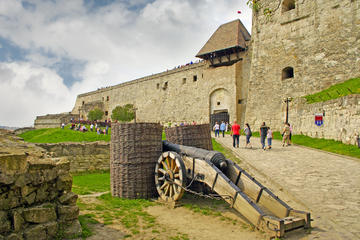 Eger
Eger Eger is the second largest city in northern Hungary and with a castle, thermal baths, historic buildings and great wine, it makes a perfect day or weekend trip from Budapest. Founded in the 10th century by St. Stephen, the first Christian king of Hungary, the city was destroyed by the Mongols
Eger
Eger Eger is the second largest city in northern Hungary and with a castle, thermal baths, historic buildings and great wine, it makes a perfect day or weekend trip from Budapest. Founded in the 10th century by St. Stephen, the first Christian king of Hungary, the city was destroyed by the Mongols
-
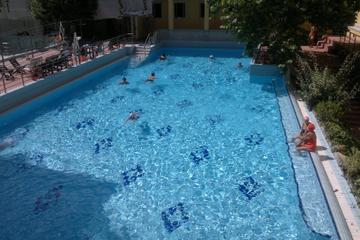 Lukács Thermal Bath
Lukács Thermal Bath Budapest is well known for its thermal baths and spas, and Lukács Thermal Bath is a favorite among locals. The underground geothermal hot spring waters were used by the St. Johns Knights starting in the 12th century and by Turkish dignitaries and soldiers in the 16th century. T
Lukács Thermal Bath
Lukács Thermal Bath Budapest is well known for its thermal baths and spas, and Lukács Thermal Bath is a favorite among locals. The underground geothermal hot spring waters were used by the St. Johns Knights starting in the 12th century and by Turkish dignitaries and soldiers in the 16th century. T
-
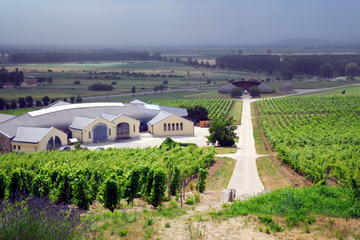 Tokaj
Tokaj Tokaj is an historic town in northern Hungary, as well as the center of the Tokaj Wine Region Historic Cultural Region, a UNESCO World Heritage Site since 2002. The region is home to almost 600 wineries and is where the world renowned Tokaji wine is produced. The oldest classified wine regio
Tokaj
Tokaj Tokaj is an historic town in northern Hungary, as well as the center of the Tokaj Wine Region Historic Cultural Region, a UNESCO World Heritage Site since 2002. The region is home to almost 600 wineries and is where the world renowned Tokaji wine is produced. The oldest classified wine regio
-
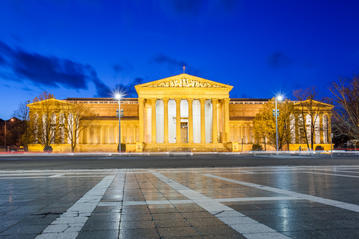 Museum of Fine Arts
Museum of Fine Arts The Museum of Fine Arts in Budapest was founded in 1896 when the collections of several institutions were combined into a single museum. The neo-classical building housing the museum opened in 1906. On the ground floor of the museum, visitors will find exhibitions of classical
Museum of Fine Arts
Museum of Fine Arts The Museum of Fine Arts in Budapest was founded in 1896 when the collections of several institutions were combined into a single museum. The neo-classical building housing the museum opened in 1906. On the ground floor of the museum, visitors will find exhibitions of classical
-
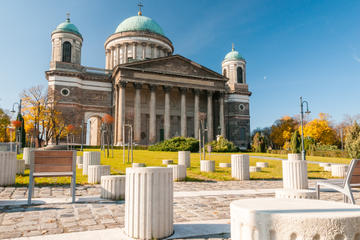 Esztergom
Esztergom Located about 30 miles northwest of Budapest, Esztergom sits on the right bank of the Danube River where it forms the border between Hungary and Slovakia. It makes a perfect day trip from Budapest. The city was the capital of Hungary from the 10th century to the middle of the 13th centur
Esztergom
Esztergom Located about 30 miles northwest of Budapest, Esztergom sits on the right bank of the Danube River where it forms the border between Hungary and Slovakia. It makes a perfect day trip from Budapest. The city was the capital of Hungary from the 10th century to the middle of the 13th centur
-
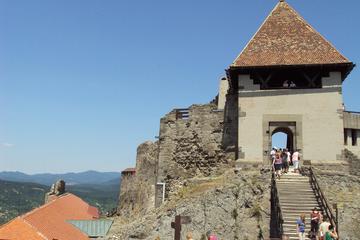 Visegrad
Visegrad Located about 25 miles north of Budapest, Visegrad is a tiny castle town on the banks of the Danube River. It makes a nice day trip from Budapest, but is also worth a couple days in its own right, as it makes a great base for hiking and other adventure sports in the surrounding area. Vise
Visegrad
Visegrad Located about 25 miles north of Budapest, Visegrad is a tiny castle town on the banks of the Danube River. It makes a nice day trip from Budapest, but is also worth a couple days in its own right, as it makes a great base for hiking and other adventure sports in the surrounding area. Vise
-
 Budai Vigado
Budai Vigado Built in the late 1800s, Budai Vigado was constructed with the intention of being both theater and library—a single building meant to meet the cultural needs and desires of local Hungarians. While the outside of this massive stately structure appears relatively unassuming, visitors ag
Budai Vigado
Budai Vigado Built in the late 1800s, Budai Vigado was constructed with the intention of being both theater and library—a single building meant to meet the cultural needs and desires of local Hungarians. While the outside of this massive stately structure appears relatively unassuming, visitors ag
-
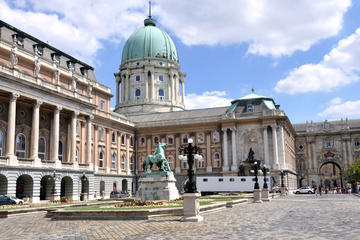 Buda Royal Palace (Kiralyi Palota)
Buda Royal Palace (Kiralyi Palota) The grandiose pile of the Királyi Palota (the Royal Palace) is the Phoenix of Budapest - its been burnt to the ground and rebuilt countless times, and was almost gone in WWII. But these days, looking at the magnificent stone edifice and haughty dome, its hard to
Buda Royal Palace (Kiralyi Palota)
Buda Royal Palace (Kiralyi Palota) The grandiose pile of the Királyi Palota (the Royal Palace) is the Phoenix of Budapest - its been burnt to the ground and rebuilt countless times, and was almost gone in WWII. But these days, looking at the magnificent stone edifice and haughty dome, its hard to
-
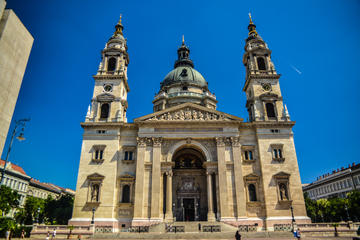 St Stephen’s Basilica (Szent Istvan Bazilika)
St Stephen’s Basilica (Szent Istvan Bazilika) This beautiful neo-classical cathedral is the biggest church in Budapest and sits on the imposing square of Szent István. Its serene façade is decorated with statues of the 12 Apostles and has twin clock towers, a vast cupola and an imposing colonnaded
St Stephen’s Basilica (Szent Istvan Bazilika)
St Stephen’s Basilica (Szent Istvan Bazilika) This beautiful neo-classical cathedral is the biggest church in Budapest and sits on the imposing square of Szent István. Its serene façade is decorated with statues of the 12 Apostles and has twin clock towers, a vast cupola and an imposing colonnaded
-
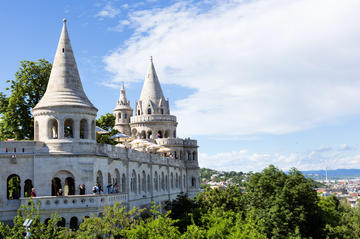 Fisherman’s Bastion (Halaszbastya)
Fisherman’s Bastion (Halaszbastya) Sitting high on Castle Hill on the Buda side of the Danube River, Fisherman’s Bastion was built in 1905 as part of the ongoing celebrations of the thousand-years existence of the Hungarian state. It encompasses part of the original fortified castle walls and its
Fisherman’s Bastion (Halaszbastya)
Fisherman’s Bastion (Halaszbastya) Sitting high on Castle Hill on the Buda side of the Danube River, Fisherman’s Bastion was built in 1905 as part of the ongoing celebrations of the thousand-years existence of the Hungarian state. It encompasses part of the original fortified castle walls and its
-
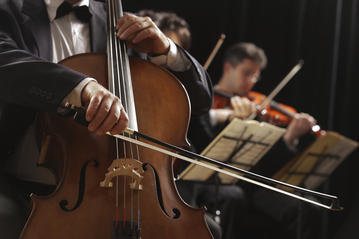 Danube Palace
Danube Palace The Danube Palace is a frothy Neo-Baroque concert hall completed in 1885 as part of Budapest’s massive expansion for the millennium celebrations. Hungary was a thousand years old in 1896 and the Habsburg Emperor Franz Joseph I was determined to create a prestigious city that reflecte
Danube Palace
Danube Palace The Danube Palace is a frothy Neo-Baroque concert hall completed in 1885 as part of Budapest’s massive expansion for the millennium celebrations. Hungary was a thousand years old in 1896 and the Habsburg Emperor Franz Joseph I was determined to create a prestigious city that reflecte
-
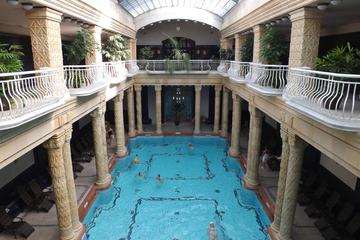 Gellért Thermal Bath and Spa
Gellért Thermal Bath and Spa Rising 140 m (460 ft) over the western flank of the River Danube, Gellért Hill is riddled with underground cave complexes and around 130 hot springs, which feed Budapest’s famous spa baths. Formed in karstic limestone, the springs have therapeutic properties and provid
Gellért Thermal Bath and Spa
Gellért Thermal Bath and Spa Rising 140 m (460 ft) over the western flank of the River Danube, Gellért Hill is riddled with underground cave complexes and around 130 hot springs, which feed Budapest’s famous spa baths. Formed in karstic limestone, the springs have therapeutic properties and provid
-
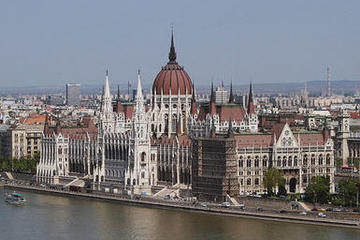 Budapest Parliament House (Orszaghaz)
Budapest Parliament House (Orszaghaz) Not many cities can boast a Parliament Building this photogenic. Sitting on the banks of the Danube, built in a grand Neo-Gothic style, this is Parliament done palatially. The idea for the construction of the Budapest Parliament House - or Orszaghaz - came in
Budapest Parliament House (Orszaghaz)
Budapest Parliament House (Orszaghaz) Not many cities can boast a Parliament Building this photogenic. Sitting on the banks of the Danube, built in a grand Neo-Gothic style, this is Parliament done palatially. The idea for the construction of the Budapest Parliament House - or Orszaghaz - came in
-
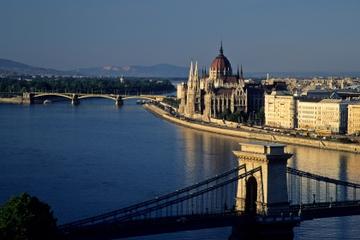 Danube River
Danube River The Danube River is the frame of all the best Budapest views, the dividing line that gives the city its dual character, and the second longest river in Europe. It richly deserves all the songs that celebrate it. If it werent for the Danube River, Budapest wouldnt have its famous serie
Danube River
Danube River The Danube River is the frame of all the best Budapest views, the dividing line that gives the city its dual character, and the second longest river in Europe. It richly deserves all the songs that celebrate it. If it werent for the Danube River, Budapest wouldnt have its famous serie
-
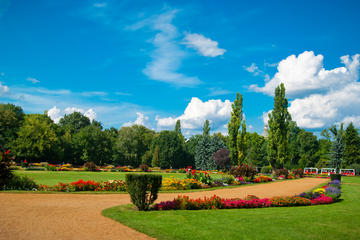 Margaret Island (Margit-sziget)
Margaret Island (Margit-sziget) Margit-sziget (Margaret Island) is a magical little piece of heaven poised between Buda and Pest. Being there always gives you the sense of taking some time off from the real world. Its small - only 2.5 km (1.4 mi) long - but youd be surprised how much the island ma
Margaret Island (Margit-sziget)
Margaret Island (Margit-sziget) Margit-sziget (Margaret Island) is a magical little piece of heaven poised between Buda and Pest. Being there always gives you the sense of taking some time off from the real world. Its small - only 2.5 km (1.4 mi) long - but youd be surprised how much the island ma
-
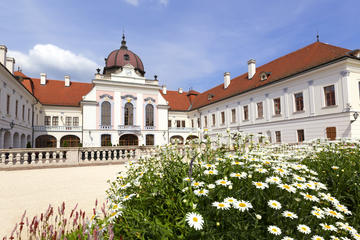 Godollo Palace
Godollo Palace Located northeast of Budapest, the Baroque treasure that is Gödöllö Palace originally belonged to the aristocratic Grassalkovich family, but by the 1890s it had been taken over by the Habsburg dynasty – who ruled the Austro-Hungarian Empire from 1526 to 1918 – as their favored summe
Godollo Palace
Godollo Palace Located northeast of Budapest, the Baroque treasure that is Gödöllö Palace originally belonged to the aristocratic Grassalkovich family, but by the 1890s it had been taken over by the Habsburg dynasty – who ruled the Austro-Hungarian Empire from 1526 to 1918 – as their favored summe
-
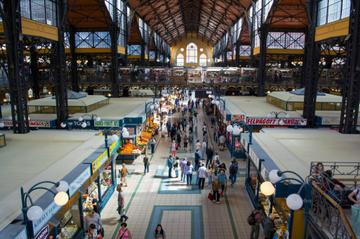 Central Market Hall
Central Market Hall The Central Market Hall is the largest indoor market in Budapest, Hungary. The ornate building is more than 100 years old and has three stories filled with stalls. The roof is still original and is covered in colorful Zsolnay tiles. There are four other markets in Budapest that
Central Market Hall
Central Market Hall The Central Market Hall is the largest indoor market in Budapest, Hungary. The ornate building is more than 100 years old and has three stories filled with stalls. The roof is still original and is covered in colorful Zsolnay tiles. There are four other markets in Budapest that
-
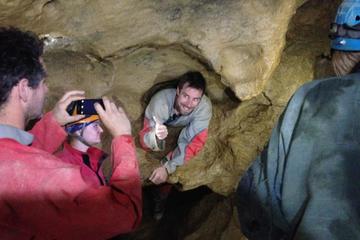 Palvolgyi Caves
Palvolgyi Caves It is well known that Budapest boasts about 130 thermal springs, formed in the karstic limestone upon which the Buda Hills stand and the source of its famous therapeutic spas, but what is less known is that around 30 km (18.5 miles) of caves and subterranean passages also riddle th
Palvolgyi Caves
Palvolgyi Caves It is well known that Budapest boasts about 130 thermal springs, formed in the karstic limestone upon which the Buda Hills stand and the source of its famous therapeutic spas, but what is less known is that around 30 km (18.5 miles) of caves and subterranean passages also riddle th
-
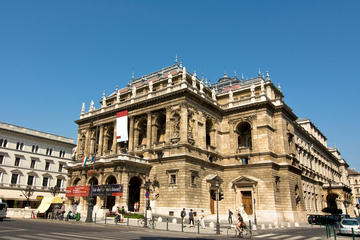 Hungarian State Opera House (Magyar Allami Operahaz)
Hungarian State Opera House (Magyar Allami Operahaz) Budapest’s main opera house is a lavish neo-Renaissance confection with an interior so ornate that it could only have been built at the height of the wealthy Austro-Hungarian Empire. The opera house was designed by the Hungarian architect Mikós
Hungarian State Opera House (Magyar Allami Operahaz)
Hungarian State Opera House (Magyar Allami Operahaz) Budapest’s main opera house is a lavish neo-Renaissance confection with an interior so ornate that it could only have been built at the height of the wealthy Austro-Hungarian Empire. The opera house was designed by the Hungarian architect Mikós
-
 Heroes Square (Hosok tere)
Heroes Square (Hosok tere) At the entrance to Budapests City Park, Heroes Square (or Hősök tere) features an impressive semi-circular sweep of columns and statues and a cenotaph honoring the fallen of the 1956 uprising. On either side of the square are the Museum of Fine Art and the Exhibition Hal
Heroes Square (Hosok tere)
Heroes Square (Hosok tere) At the entrance to Budapests City Park, Heroes Square (or Hősök tere) features an impressive semi-circular sweep of columns and statues and a cenotaph honoring the fallen of the 1956 uprising. On either side of the square are the Museum of Fine Art and the Exhibition Hal
Total
602 -travel
FirstPage PreviousPage NextPage LastPage CurrentPage:
2/31 20-travel/Page GoTo Page:
 Eger
Eger Eger is the second largest city in northern Hungary and with a castle, thermal baths, historic buildings and great wine, it makes a perfect day or weekend trip from Budapest. Founded in the 10th century by St. Stephen, the first Christian king of Hungary, the city was destroyed by the Mongols
Eger
Eger Eger is the second largest city in northern Hungary and with a castle, thermal baths, historic buildings and great wine, it makes a perfect day or weekend trip from Budapest. Founded in the 10th century by St. Stephen, the first Christian king of Hungary, the city was destroyed by the Mongols
 Lukács Thermal Bath
Lukács Thermal Bath Budapest is well known for its thermal baths and spas, and Lukács Thermal Bath is a favorite among locals. The underground geothermal hot spring waters were used by the St. Johns Knights starting in the 12th century and by Turkish dignitaries and soldiers in the 16th century. T
Lukács Thermal Bath
Lukács Thermal Bath Budapest is well known for its thermal baths and spas, and Lukács Thermal Bath is a favorite among locals. The underground geothermal hot spring waters were used by the St. Johns Knights starting in the 12th century and by Turkish dignitaries and soldiers in the 16th century. T
 Tokaj
Tokaj Tokaj is an historic town in northern Hungary, as well as the center of the Tokaj Wine Region Historic Cultural Region, a UNESCO World Heritage Site since 2002. The region is home to almost 600 wineries and is where the world renowned Tokaji wine is produced. The oldest classified wine regio
Tokaj
Tokaj Tokaj is an historic town in northern Hungary, as well as the center of the Tokaj Wine Region Historic Cultural Region, a UNESCO World Heritage Site since 2002. The region is home to almost 600 wineries and is where the world renowned Tokaji wine is produced. The oldest classified wine regio
 Museum of Fine Arts
Museum of Fine Arts The Museum of Fine Arts in Budapest was founded in 1896 when the collections of several institutions were combined into a single museum. The neo-classical building housing the museum opened in 1906. On the ground floor of the museum, visitors will find exhibitions of classical
Museum of Fine Arts
Museum of Fine Arts The Museum of Fine Arts in Budapest was founded in 1896 when the collections of several institutions were combined into a single museum. The neo-classical building housing the museum opened in 1906. On the ground floor of the museum, visitors will find exhibitions of classical
 Esztergom
Esztergom Located about 30 miles northwest of Budapest, Esztergom sits on the right bank of the Danube River where it forms the border between Hungary and Slovakia. It makes a perfect day trip from Budapest. The city was the capital of Hungary from the 10th century to the middle of the 13th centur
Esztergom
Esztergom Located about 30 miles northwest of Budapest, Esztergom sits on the right bank of the Danube River where it forms the border between Hungary and Slovakia. It makes a perfect day trip from Budapest. The city was the capital of Hungary from the 10th century to the middle of the 13th centur
 Visegrad
Visegrad Located about 25 miles north of Budapest, Visegrad is a tiny castle town on the banks of the Danube River. It makes a nice day trip from Budapest, but is also worth a couple days in its own right, as it makes a great base for hiking and other adventure sports in the surrounding area. Vise
Visegrad
Visegrad Located about 25 miles north of Budapest, Visegrad is a tiny castle town on the banks of the Danube River. It makes a nice day trip from Budapest, but is also worth a couple days in its own right, as it makes a great base for hiking and other adventure sports in the surrounding area. Vise
 Budai Vigado
Budai Vigado Built in the late 1800s, Budai Vigado was constructed with the intention of being both theater and library—a single building meant to meet the cultural needs and desires of local Hungarians. While the outside of this massive stately structure appears relatively unassuming, visitors ag
Budai Vigado
Budai Vigado Built in the late 1800s, Budai Vigado was constructed with the intention of being both theater and library—a single building meant to meet the cultural needs and desires of local Hungarians. While the outside of this massive stately structure appears relatively unassuming, visitors ag
 Buda Royal Palace (Kiralyi Palota)
Buda Royal Palace (Kiralyi Palota) The grandiose pile of the Királyi Palota (the Royal Palace) is the Phoenix of Budapest - its been burnt to the ground and rebuilt countless times, and was almost gone in WWII. But these days, looking at the magnificent stone edifice and haughty dome, its hard to
Buda Royal Palace (Kiralyi Palota)
Buda Royal Palace (Kiralyi Palota) The grandiose pile of the Királyi Palota (the Royal Palace) is the Phoenix of Budapest - its been burnt to the ground and rebuilt countless times, and was almost gone in WWII. But these days, looking at the magnificent stone edifice and haughty dome, its hard to
 St Stephen’s Basilica (Szent Istvan Bazilika)
St Stephen’s Basilica (Szent Istvan Bazilika) This beautiful neo-classical cathedral is the biggest church in Budapest and sits on the imposing square of Szent István. Its serene façade is decorated with statues of the 12 Apostles and has twin clock towers, a vast cupola and an imposing colonnaded
St Stephen’s Basilica (Szent Istvan Bazilika)
St Stephen’s Basilica (Szent Istvan Bazilika) This beautiful neo-classical cathedral is the biggest church in Budapest and sits on the imposing square of Szent István. Its serene façade is decorated with statues of the 12 Apostles and has twin clock towers, a vast cupola and an imposing colonnaded
 Fisherman’s Bastion (Halaszbastya)
Fisherman’s Bastion (Halaszbastya) Sitting high on Castle Hill on the Buda side of the Danube River, Fisherman’s Bastion was built in 1905 as part of the ongoing celebrations of the thousand-years existence of the Hungarian state. It encompasses part of the original fortified castle walls and its
Fisherman’s Bastion (Halaszbastya)
Fisherman’s Bastion (Halaszbastya) Sitting high on Castle Hill on the Buda side of the Danube River, Fisherman’s Bastion was built in 1905 as part of the ongoing celebrations of the thousand-years existence of the Hungarian state. It encompasses part of the original fortified castle walls and its
 Danube Palace
Danube Palace The Danube Palace is a frothy Neo-Baroque concert hall completed in 1885 as part of Budapest’s massive expansion for the millennium celebrations. Hungary was a thousand years old in 1896 and the Habsburg Emperor Franz Joseph I was determined to create a prestigious city that reflecte
Danube Palace
Danube Palace The Danube Palace is a frothy Neo-Baroque concert hall completed in 1885 as part of Budapest’s massive expansion for the millennium celebrations. Hungary was a thousand years old in 1896 and the Habsburg Emperor Franz Joseph I was determined to create a prestigious city that reflecte
 Gellért Thermal Bath and Spa
Gellért Thermal Bath and Spa Rising 140 m (460 ft) over the western flank of the River Danube, Gellért Hill is riddled with underground cave complexes and around 130 hot springs, which feed Budapest’s famous spa baths. Formed in karstic limestone, the springs have therapeutic properties and provid
Gellért Thermal Bath and Spa
Gellért Thermal Bath and Spa Rising 140 m (460 ft) over the western flank of the River Danube, Gellért Hill is riddled with underground cave complexes and around 130 hot springs, which feed Budapest’s famous spa baths. Formed in karstic limestone, the springs have therapeutic properties and provid
 Budapest Parliament House (Orszaghaz)
Budapest Parliament House (Orszaghaz) Not many cities can boast a Parliament Building this photogenic. Sitting on the banks of the Danube, built in a grand Neo-Gothic style, this is Parliament done palatially. The idea for the construction of the Budapest Parliament House - or Orszaghaz - came in
Budapest Parliament House (Orszaghaz)
Budapest Parliament House (Orszaghaz) Not many cities can boast a Parliament Building this photogenic. Sitting on the banks of the Danube, built in a grand Neo-Gothic style, this is Parliament done palatially. The idea for the construction of the Budapest Parliament House - or Orszaghaz - came in
 Danube River
Danube River The Danube River is the frame of all the best Budapest views, the dividing line that gives the city its dual character, and the second longest river in Europe. It richly deserves all the songs that celebrate it. If it werent for the Danube River, Budapest wouldnt have its famous serie
Danube River
Danube River The Danube River is the frame of all the best Budapest views, the dividing line that gives the city its dual character, and the second longest river in Europe. It richly deserves all the songs that celebrate it. If it werent for the Danube River, Budapest wouldnt have its famous serie
 Margaret Island (Margit-sziget)
Margaret Island (Margit-sziget) Margit-sziget (Margaret Island) is a magical little piece of heaven poised between Buda and Pest. Being there always gives you the sense of taking some time off from the real world. Its small - only 2.5 km (1.4 mi) long - but youd be surprised how much the island ma
Margaret Island (Margit-sziget)
Margaret Island (Margit-sziget) Margit-sziget (Margaret Island) is a magical little piece of heaven poised between Buda and Pest. Being there always gives you the sense of taking some time off from the real world. Its small - only 2.5 km (1.4 mi) long - but youd be surprised how much the island ma
 Godollo Palace
Godollo Palace Located northeast of Budapest, the Baroque treasure that is Gödöllö Palace originally belonged to the aristocratic Grassalkovich family, but by the 1890s it had been taken over by the Habsburg dynasty – who ruled the Austro-Hungarian Empire from 1526 to 1918 – as their favored summe
Godollo Palace
Godollo Palace Located northeast of Budapest, the Baroque treasure that is Gödöllö Palace originally belonged to the aristocratic Grassalkovich family, but by the 1890s it had been taken over by the Habsburg dynasty – who ruled the Austro-Hungarian Empire from 1526 to 1918 – as their favored summe
 Central Market Hall
Central Market Hall The Central Market Hall is the largest indoor market in Budapest, Hungary. The ornate building is more than 100 years old and has three stories filled with stalls. The roof is still original and is covered in colorful Zsolnay tiles. There are four other markets in Budapest that
Central Market Hall
Central Market Hall The Central Market Hall is the largest indoor market in Budapest, Hungary. The ornate building is more than 100 years old and has three stories filled with stalls. The roof is still original and is covered in colorful Zsolnay tiles. There are four other markets in Budapest that
 Palvolgyi Caves
Palvolgyi Caves It is well known that Budapest boasts about 130 thermal springs, formed in the karstic limestone upon which the Buda Hills stand and the source of its famous therapeutic spas, but what is less known is that around 30 km (18.5 miles) of caves and subterranean passages also riddle th
Palvolgyi Caves
Palvolgyi Caves It is well known that Budapest boasts about 130 thermal springs, formed in the karstic limestone upon which the Buda Hills stand and the source of its famous therapeutic spas, but what is less known is that around 30 km (18.5 miles) of caves and subterranean passages also riddle th
 Hungarian State Opera House (Magyar Allami Operahaz)
Hungarian State Opera House (Magyar Allami Operahaz) Budapest’s main opera house is a lavish neo-Renaissance confection with an interior so ornate that it could only have been built at the height of the wealthy Austro-Hungarian Empire. The opera house was designed by the Hungarian architect Mikós
Hungarian State Opera House (Magyar Allami Operahaz)
Hungarian State Opera House (Magyar Allami Operahaz) Budapest’s main opera house is a lavish neo-Renaissance confection with an interior so ornate that it could only have been built at the height of the wealthy Austro-Hungarian Empire. The opera house was designed by the Hungarian architect Mikós
 Heroes Square (Hosok tere)
Heroes Square (Hosok tere) At the entrance to Budapests City Park, Heroes Square (or Hősök tere) features an impressive semi-circular sweep of columns and statues and a cenotaph honoring the fallen of the 1956 uprising. On either side of the square are the Museum of Fine Art and the Exhibition Hal
Heroes Square (Hosok tere)
Heroes Square (Hosok tere) At the entrance to Budapests City Park, Heroes Square (or Hősök tere) features an impressive semi-circular sweep of columns and statues and a cenotaph honoring the fallen of the 1956 uprising. On either side of the square are the Museum of Fine Art and the Exhibition Hal